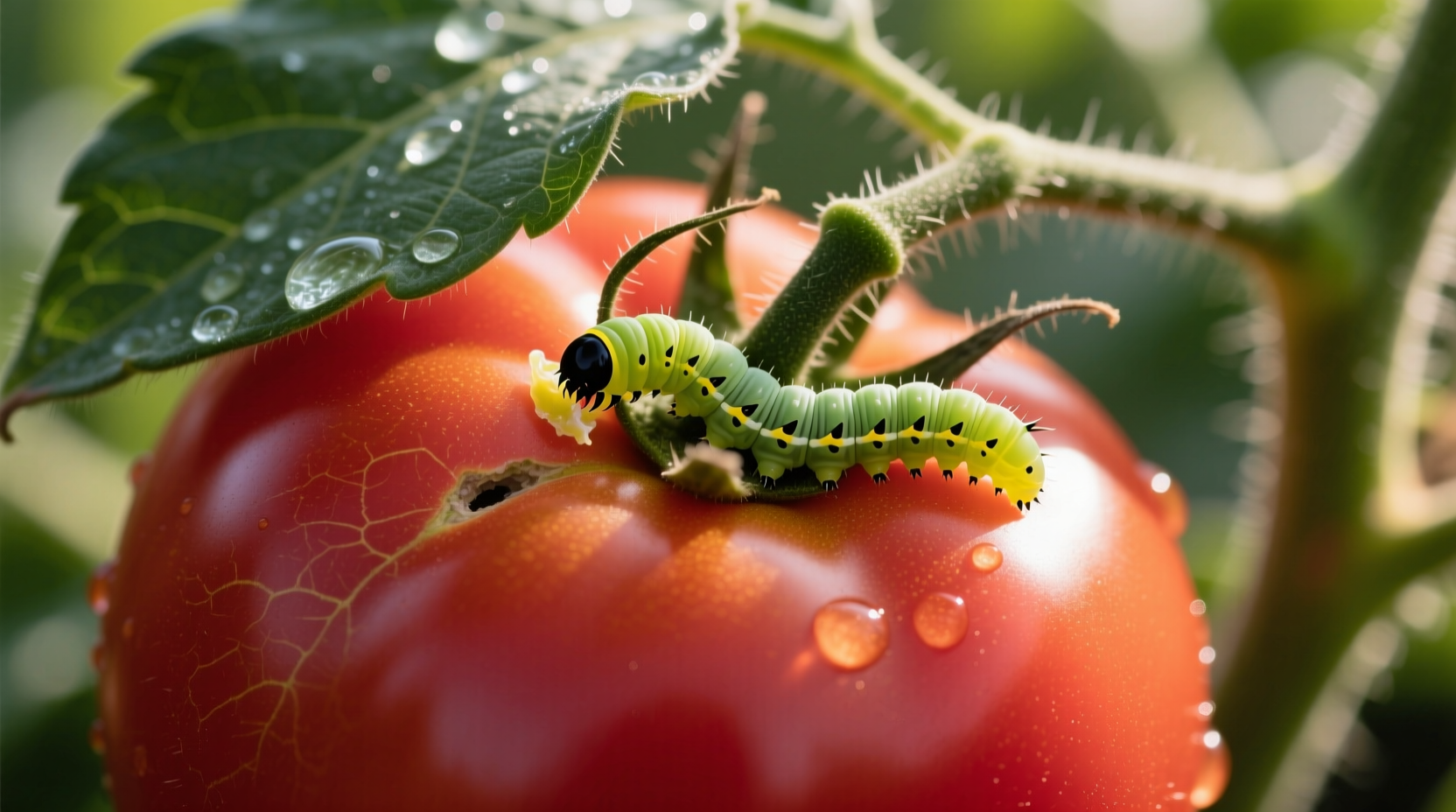Identifying Tomato Fruit Worms: What You're Dealing With
Tomato fruit worms, scientifically known as Helicoverpa zea, are the larval stage of the corn earworm moth. These pests target tomatoes specifically when fruits begin ripening, creating entry holes near the stem that lead to internal tunneling. Unlike tomato hornworms that feed externally on leaves and stems, fruit worms work from the inside out, making them harder to detect until damage is severe.
Adult moths lay single eggs on upper leaf surfaces that hatch in 2-4 days. The caterpillars grow to 1.5 inches long with variable coloring—ranging from green to brown to pink—with distinctive black spots along their sides. Their heads are typically yellowish-brown. This color variation often causes misidentification, leading gardeners to waste time on ineffective treatments.

Life Cycle Timeline: When to Expect Infestations
Understanding the pest's development cycle is crucial for effective intervention. Tomato fruit worms follow this seasonal pattern:
| Stage | Duration | Key Characteristics | Optimal Intervention |
|---|---|---|---|
| Egg | 2-4 days | Creamy white, dome-shaped, on upper leaf surfaces | Apply neem oil spray |
| Larva (early) | 7-10 days | Small (1/4 inch), light green, feed on leaves | Bt application most effective |
| Larva (mature) | 14-21 days | 1-1.5 inches, variable colors, enter fruit | Hand-picking, remove infested fruit |
| Pupa | 10-14 days | Brown cocoons in soil | Cultivate soil, add beneficial nematodes |
| Adult moth | 5-15 days | Tan/brown wings, 1.5 inch span | Pheromone traps, reduce evening lighting |
Multiple generations occur annually in warm climates, with peak activity from mid-summer through fall when tomatoes are ripening. The University of California Integrated Pest Management Program notes that fruit worms become significantly more problematic when nighttime temperatures remain above 65°F (18°C) for consecutive weeks.
Organic Control Methods That Actually Work
Chemical pesticides often prove ineffective against tomato fruit worms because the larvae feed protected inside the fruit. Organic approaches targeting vulnerable life stages yield better results:
Preventive Measures
Row covers installed after flowering but before fruit set create a physical barrier against egg-laying moths. The Cornell University Garden-Based Learning program confirms this method reduces infestations by 80-90% when properly maintained. Use lightweight fabric (0.5-1.0 oz/yd²) that allows pollination while blocking moths.
Companion planting with basil, marigolds, or borage disrupts the pests' ability to locate tomato plants. Research from the USDA Agricultural Research Service shows that interplanting tomatoes with aromatic herbs reduces fruit worm incidence by 35-45% compared to monoculture plantings.
Biological Controls
Trichogramma wasps (available from garden suppliers) parasitize fruit worm eggs. Release 5,000 wasps per 1,000 square feet weekly during peak moth activity. Field trials by Michigan State University Extension demonstrated 60-75% egg parasitism rates with proper application timing.
Bacillus thuringiensis (Bt) works only on young caterpillars. Apply Bacillus thuringiensis var. kurstaki every 5-7 days during egg hatch periods. The organic compound breaks down quickly in sunlight, so evening applications provide optimal effectiveness.
When and How to Use Targeted Treatments
For established infestations, combine multiple approaches:
- Hand-picking: Inspect plants daily at dawn when larvae are most active. Wear gloves and drop worms into soapy water.
- Neem oil spray: Mix 2 tablespoons neem oil with 1 teaspoon dish soap per gallon of water. Spray thoroughly on upper and lower leaf surfaces every 5-7 days.
- Pyrethrin-based sprays: Use as a last resort for severe infestations. Apply only in evening to minimize impact on beneficial insects.
- Infested fruit removal: Immediately harvest and discard any tomatoes showing entry holes to prevent larvae migration.
Timing matters significantly. The University of Florida IFAS Extension emphasizes that treatments applied during the egg stage or early larval development (before worms enter fruit) are 3-5 times more effective than interventions targeting mature larvae inside tomatoes.
Long-Term Prevention Strategies
Breaking the pest cycle requires seasonal planning:
Crop rotation is essential—avoid planting tomatoes or related crops (peppers, eggplants, potatoes) in the same location for at least 2-3 years. The USDA Natural Resources Conservation Service confirms this practice reduces overwintering pupae populations by 60-75%.
Soil cultivation after harvest destroys overwintering pupae. Turn soil to 4-6 inch depth in late fall when temperatures drop below 50°F (10°C), exposing pupae to predators and cold.
Monitoring with pheromone traps helps detect moth activity before egg laying begins. Place traps at plant height and check weekly. When moths appear consistently, begin protective measures.
Successful tomato growers in fruit worm-prone regions typically implement 3-4 complementary strategies rather than relying on a single method. This integrated approach creates multiple barriers that significantly reduce pest pressure throughout the growing season.
Frequently Asked Questions
Can tomato fruit worms harm humans if I accidentally eat infested fruit?
No, tomato fruit worms pose no health risk to humans if accidentally consumed. The FDA confirms that ingesting small amounts of these caterpillars or their frass (excrement) is harmless, though understandably unpleasant. Simply cut away damaged portions of the fruit and enjoy the unaffected parts.
What's the difference between tomato fruit worms and tomato hornworms?
Tomato fruit worms (Helicoverpa zea) are smaller (1-1.5 inches), variable in color, and burrow directly into fruit. Tomato hornworms (Manduca quinquemaculata) are larger (3-4 inches), bright green with white V-shaped markings, and feed externally on leaves and stems. Fruit worms cause internal damage while hornworms create visible defoliation.
Are there tomato varieties resistant to fruit worms?
While no tomato variety is completely resistant, thicker-skinned varieties like 'Rutgers,' 'Celebrity,' and 'Mountain Merit' show reduced susceptibility. The University of Georgia Extension reports these varieties experience 25-40% less infestation compared to thin-skinned heirlooms. Look for varieties with higher levels of trichomes (hair-like structures) which deter egg-laying.
How soon after treatment can I harvest tomatoes?
With organic treatments like Bt or neem oil, you can harvest immediately after application. The EPA confirms these compounds break down quickly and pose no residue concerns. For pyrethrin-based sprays, wait at least 3 days before harvesting. Always wash tomatoes thoroughly before consumption regardless of treatment method.











 浙公网安备
33010002000092号
浙公网安备
33010002000092号 浙B2-20120091-4
浙B2-20120091-4